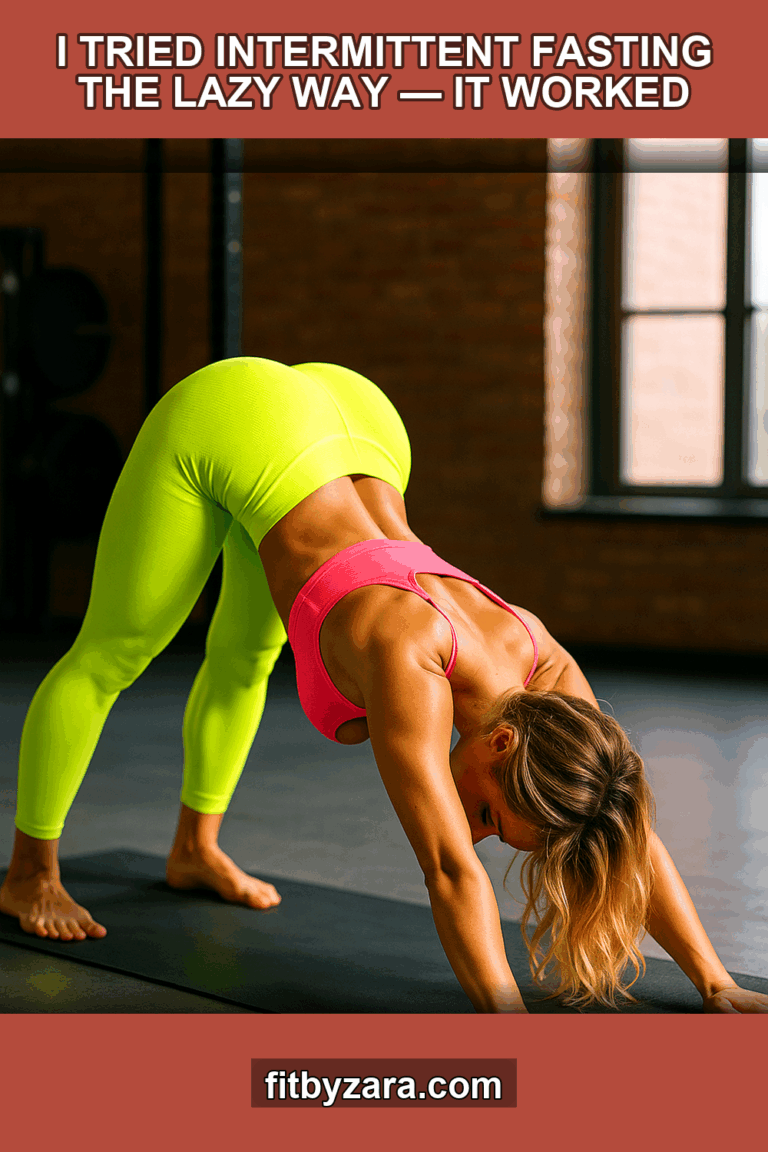Are you curious about intermittent fasting but don’t want to dive into the usual strict rules and regulations? You’re not alone. As women over 30, we often juggle careers, families, and personal well-being, leaving little time for complicated diets. But what if I told you that intermittent fasting could be easier than you think? I experimented with a lazy approach to intermittent fasting, and it worked wonders for me. Here’s how I did it.

Hi, I’m Zara — fitness junkie, wellness nerd, and the voice behind FitByZara.com. This site is all about smart fitness and science-backed wellness tips for real women who want to feel their best.
What is Intermittent Fasting?
3-Day Energy & Metabolism Reset
Grab the 3-Day Energy & Metabolism Reset — a quick-start guide to feel lighter, more energized, and back in control.

Where should I send your free reset guide?
Intermittent fasting (IF) is an eating pattern that cycles between periods of fasting and eating. Rather than focusing on what you eat, it emphasizes when you eat. There are various methods, but they generally involve skipping meals or limiting eating to specific time windows.
Popular Methods of Intermittent Fasting
- 16/8 Method: Fast for 16 hours and eat during an 8-hour window.
- 5:2 Diet: Eat normally for five days and limit calories to 500-600 for two non-consecutive days.
- Eat-Stop-Eat: Fasting for a full 24 hours once or twice a week.
Why I Tried Intermittent Fasting
As someone who’s passionate about wellness and maintaining balance, I wanted to explore intermittent fasting for its potential benefits, including:
- Improved energy levels
- Enhanced focus
- Weight management
However, I didn’t want to stress myself out. Enter: the lazy approach.
My Lazy Intermittent Fasting Experiment
I decided to keep things simple and intuitive. Here’s how I adapted intermittent fasting to fit my lifestyle:
Step 1: Choose My Eating Window
Instead of adhering to a strict 16/8 schedule, I opted for a more flexible 12/12 approach. This meant I would fast for 12 hours overnight and eat during the other 12 hours.
How to Set Your Eating Window
- Dinner to Breakfast: If I finished dinner by 7 PM, I wouldn’t eat again until 7 AM.
- Listen to Your Body: Some days I might extend the fast, but I always kept it easy and natural.
Step 2: Focus on Whole Foods
I didn’t want to complicate my meals. I prioritized whole, nutrient-dense foods during my eating window. This kept me satisfied and energized.
My Go-To Foods:
- Fruits and Veggies: Fresh, colorful options like berries, spinach, and carrots.
- Lean Proteins: Grilled chicken, fish, and legumes.
- Healthy Fats: Avocado, nuts, and olive oil.
Step 3: Stay Hydrated
Staying hydrated during both fasting and eating periods was crucial. I made sure to drink plenty of water, herbal teas, and black coffee. This helped curb any hunger pangs and kept my energy levels up.
Step 4: Be Flexible and Kind to Myself
If I felt hungry outside my eating window, I allowed myself to adjust. Life happens, and I didn’t want to make this a stressful endeavor. I listened to my body and adjusted as needed.
The Results
After a month of this lazy intermittent fasting approach, I noticed:
- Better Energy Levels: I felt more energized throughout the day.
- Improved Digestion: My digestive system felt more balanced.
- Weight Management: I found it easier to maintain my weight without feeling deprived.
“Intermittent fasting doesn’t have to be rigid. A relaxed approach can still yield amazing results.”
Tips for Women 30+ Trying Lazy Intermittent Fasting
If you’re considering giving this a whirl, here’s a mini checklist to get started:
Mini Checklist for Lazy Intermittent Fasting
- [ ] Set a Flexible Eating Window: Start with 12/12 and adjust as needed.
- [ ] Choose Whole Foods: Focus on nutrient-dense options.
- [ ] Stay Hydrated: Drink plenty of water, herbal teas, and black coffee.
- [ ] Listen to Your Body: Don’t stress about sticking to strict rules.
- [ ] Be Kind to Yourself: It’s okay to adjust your plan based on how you feel.
Challenges I Faced
While my lazy approach worked well for me, it wasn’t without its hurdles. Here’s what I encountered:
1. Social Situations
Navigating social events can be tricky when you’re trying to stick to an eating window. I learned to let go of the guilt and enjoy the moment.
2. Initial Hunger Pangs
In the beginning, I experienced some hunger pangs, especially in the mornings. I found that staying hydrated and keeping busy helped distract me.
3. Mindset Shift
Adjusting my mindset was crucial. I had to let go of the pressure to follow a strict plan and embrace a more relaxed approach to eating.
How to Make It Work for You
Here are some ways to ensure that lazy intermittent fasting resonates with your lifestyle:
1. Start Slow
If you’re new to fasting, start with shorter fasting windows and gradually increase them as you feel comfortable.
2. Create a Support System
Share your journey with friends or family who might be interested in trying it, too. Having a support system makes it easier to stay accountable.
3. Experiment with Timing
Find the eating window that suits your schedule. Whether it’s breakfast or dinner, flexibility is key!
Conclusion
Intermittent fasting doesn’t have to be complicated or stressful. My lazy approach proved that by being intuitive and flexible, you can enjoy the benefits without the burden. If you’re a woman over 30 looking for a way to enhance your wellness journey, consider giving this method a try.
Your Journey Awaits!
Remember, wellness is a personal journey. Listen to your body, be kind to yourself, and most importantly, enjoy the process. Happy fasting!
—
Feel free to share your experiences with intermittent fasting in the comments! I’d love to hear how it goes for you.
HepatoBurn: Gentle Support for Steadier Days
When you’re stacking real habits—protein-forward meals, steps, and 7–9 hours of sleep—HepatoBurn is a simple add-on that supports the system behind energy, appetite, and metabolic rhythm.
Why Women 30+ Use It
- Pairs with an already-solid routine—no jitters, no crash.
- Easy to remember: 2 capsules with meals.
- Plays well with protein, walking, and strength training.
How to Use
- Timing: Breakfast & lunch are easy wins.
- Consistency: Use daily for a fair assessment.
- Stacks: Protein-first plates, post-meal walks, lights-down wind-down.
What It Isn’t
- Not a stimulant and not a magic fix.
- Best used alongside habits you’ll actually keep.
- Educational only—talk to your provider before new supplements.
Important: Educational only, not medical advice. Supplements don’t diagnose, treat, cure, or prevent diseases. Talk to your provider before changes to diet, exercise, or supplements.






















